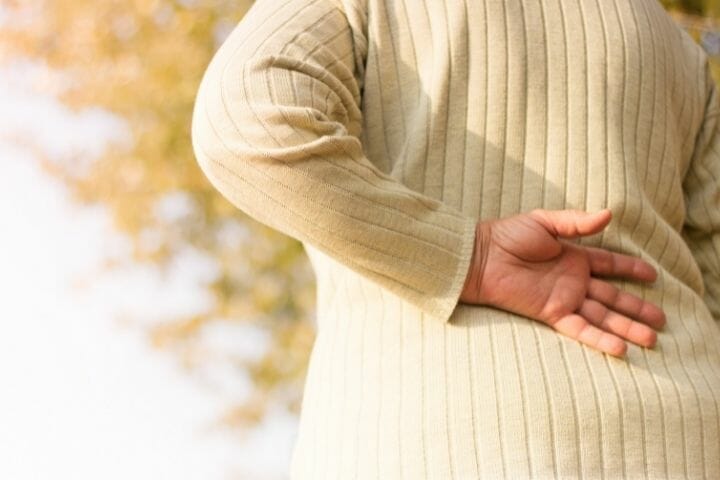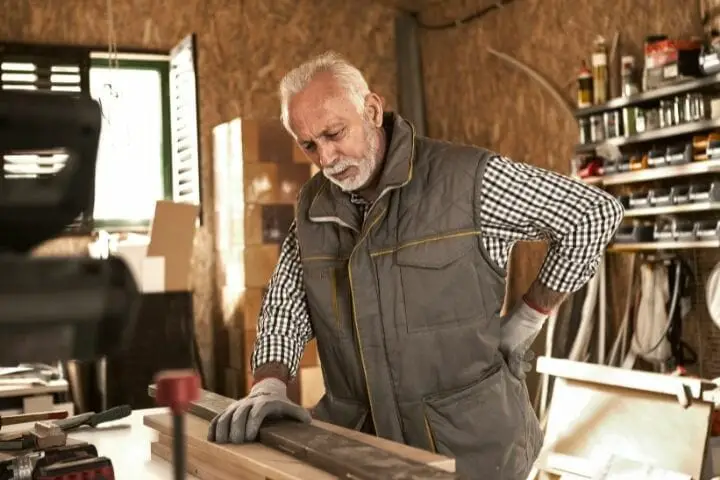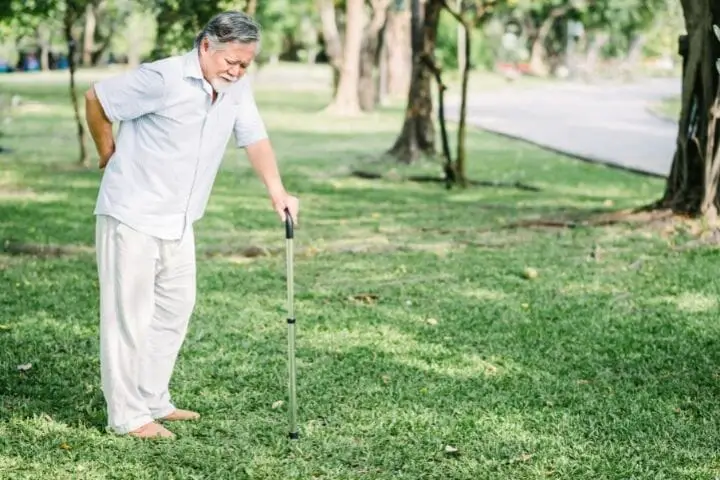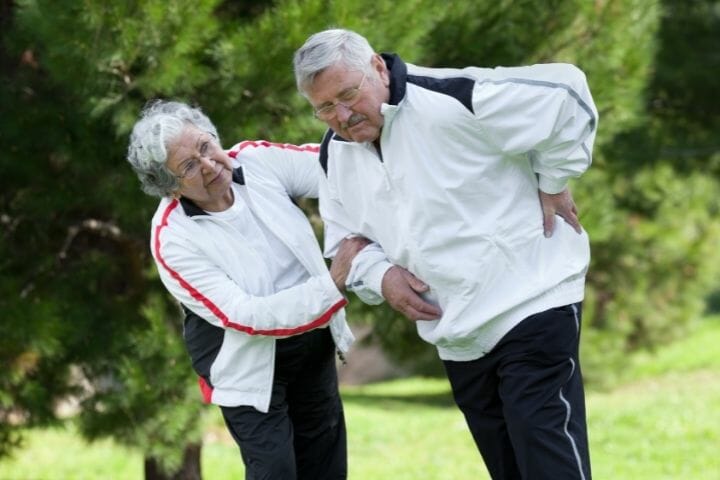Back pain is one of the most common problems that seniors face. In this article, we will talk about managing back pain for seniors.
Contents
As your spine ages, you may feel some problems and aches in your back. There are multiple reasons for back pain. There are several ways by which you can overcome this back pain. Studies have indicated that around 36 to 70 % of people suffer from back pain out of people who go through musculoskeletal pain.

Being an elder, you need to take preventive measures to manage back pain. Back pain can be reduced over time by taking the necessary guidance and working on it. In this article, you will learn about the types of back pain and ways to manage it.
Many people suffer from excruciating back pain. Spine health holds to be a significant aspect when it comes to everyday function and mobility. You need to understand your back pain lies in which category. This will help you take preventive measures for your back pain and live life to the fullest.
You might like to read: What is the Difference Between Osteoarthritis and Osteoporosis?
The Types Of Back Pain Which Occurs In Elders
Lower back pain and stiffness in the back
Symptoms:
- You may experience extreme pain in the morning and at the end of the day.
- Steady or intermittent pain in the lower back. It may extend if you perform any strenuous activity.
- Loss of mobility in the back.
- Tenderness in the back when you touch the spine.
Cause: Facet joint osteoarthritis
Facet joint osteoarthritis is also called degenerative arthritis. It is degenerative arthritis that occurs as we age. The cartilage breaks down the facet joints in the spine. Due to this, we feel the pain in the beginning. The symptoms are less visible; however, they can develop into constant lower back pain over the period.
Leg pain while walking or standing.
Symptoms:
- Numbness, weakness, and pain that radiates down from lower back to buttocks and legs
- Not being able to walk for longer distances
- Symptoms radiate from mild to severe
- You suffer from symptoms eventually
Causes: Lumbar stenosis / Degenerative spondylolisthesis:
Stenosis, as well as spondylolisthesis, leads to pressure on the nerves of the spine. Standing and doing activities such as regular walking and running increases pressure on the nerves of spines. This results in leg pain.
Limited flexibility, height loss as well as the onset of back pain
Symptoms:
- Height loss
- Reduced spinal flexibility
- Deformity
- Disability
- Sudden onset of back pain
- Walking or standing erect worsens the pain.
Causes: Spinal compression fracture
Spinal compression factor occurs after the sudden onset of back pain in people over the age of 50. Postmenopausal women who suffer from osteoporosis suffer from a spinal compression fracture.
Men or women who use corticosteroids long-term are known to suffer from a spinal compression fracture. People who suffer from spinal compression fracture may develop a compression fracture even if a small amount of pressure is exerted on the spine.
You might like to read: How To Use A TENS Machine For Back Pain

Back Exercises That You Can Perform To Overcome Back Pain
Chest and neck stretch
Chest and neck stretch can fix the wrong posture. It stretches the two muscles in your neck named trapezius, as well as scapulae. It also works your pectorals, erector spinae, and obliques.
How to perform:
You can perform this exercise by sitting on a chair and keeping your feet flat on the ground. Try to place your hands to the base of the skull and make sure that your thumb touches your ear. Try to face in an upward direction towards the ceiling and relax.
Practice inhaling and exhaling. Try to relax the left elbow as it will be pointing towards the ground and the right elbow as it will be pointing towards the ceiling. Do it vice a verse. Stretch as much as you can. You can do it three to four times on both the alternate hands.
Guidelines:
- Make sure you are sitting in the correct position.
- Practice breathing
Seated gentle backbend
By doing this exercise, your anterior neck muscles, pectorals, as well as spinal extensors, relax. Our cervical and thoracic spine begin to curve as we age. By doing this exercise, you can fix it.
How to perform:
- Be seated and keep your feet flat on the floor.
- Try to keep your hands on your lower back. Your fingers should wrap around the hips.
- Try to keep your hands firm.
You can start breathing. You can arch your spine by moving your head in the upward direction. Try to move your chin upward by facing towards the ceiling. Take 5 to 6 breaths and gently come back into the neutral starting position.
Guidelines: Do not drop your head back too much by keeping your posture correct.
You might like to read: Physical Therapy Over Opioids for Pain Management
Reach back exercise
This body stretch exercise will work on your pectorals as well as anterior deltoids.
How to perform: Try to sit straight on the ground: practice inhaling and exhaling. As you begin exhaling, try to reach back by keeping your crossed and entangled with each other.
In the initial stages, if you aren’t able to cross your fingers, you can hold your elbows and wrists. Try to roll your shoulders up and back. You can perform 3 to 4 repetitions of this exercise daily.
Guidelines: Don’t force yourself if you cannot cross your fingers.
Seated cat-cow position
Many people suffer from osteoarthritis and spinal degeneration as they age. This position will help you strengthen your lower back muscles and core muscles and keep your spine healthy.
Since it is a pose of two muscles, it works on all the muscles like erector spinae, rectus abdominis, serratus anterior, and iliac rib.
Sit straight on the ground on the chair and keep your knees at 90-degree angles. Try to keep your hands on your knees. Make sure that your fingers point towards each other: practice inhaling and exhaling. Try to press your hands and arch your back using your entire spine.
You will notice that you are pressing your butt behind you.
When you exhale, try to put your belly button to work. Drop your chin down. Put your chest back and forth and repeat these movements. You can perform 5 to 6 repetitions of this exercise.

You might like to read: Can Scoliosis Kill You
When Should You See A Doctor For Back Pain?
Most of the back pain fades away with home treatments and medications within a few weeks. But you need to contact your doctor immediately if:
- Extreme pain that doesn’t go away or returns after using home remedies like icing or over-the-counter medications, or massage or physical therapies.
- The back pain persists even after a few weeks.
- This pain moves or shoots to the glutes or legs.
- You experience some unexplained weight loss.
- You experience weakness, tingling, or numbness in your legs.
- Your movement is restricted due to pain.
- The fever is staying for longer than expected.
- There is no relief from pain even after resting for a few weeks.
- There is no relief even after taking the medicines for pain.
- Regular tightness or stiffness, especially after lying down, sitting, or standing for long periods
- In some rare conditions, you might experience new bowel problems.
The 3 Categories Of Back Pain
If you are experiencing back pain, then keep track of how long the symptoms last? This will help doctors diagnose what you are going through. They can provide you with ways that you can deal with it.
Acute pain
Acute pain is also known as short-term pain. When you get a sharp pain in your back, it may last from one day to at least one month. You could correlate it if you suffered from a specific event or injury, such as lifting heavy weights, falling from a height, or bending in an inappropriate manner while working.
Acute pain goes away as the muscle heals or when the swelling reduces. But it is indispensable that you visit the doctor depending upon how severe your pain is? And you can perform your daily activities or not.
Subacute pain
Subacute pain lasts longer, from one month to three months. It is recommended to visit the doctor to understand whether the pain will heal itself or is going to cause chronic pain.
Chronic pain
Chronic back pain lasts for more than three months. In some cases, the pain is excruciating, and other times it’s just a normal ache or one-hour series of constant back pain.
If you leave it as it is, it may negatively impact your entire posture and psyche. It becomes a bit difficult to diagnose chronic pain. If you have developed injuries, chronic pain may be there even after you have overcome the injuries.

You might like to read: Is Yoga Good For Osteoporosis?
The Chronic Back Pain Overview
Chronic back pain usually occurs with age. However, an injury or accident can also be the reason for chronic back pain.
It is often difficult to understand the leading cause of chronic back pain. In this condition, you can reach your doctor. With the help of non-surgical treatments, you can manage the symptoms and pain.
What are the causes of chronic back pain?
Disc problems: Herniated disc or bulging disc can be the reason for chronic back pain.
Myofascial pain syndrome: A person going through this disorder suffers from severe muscle pain and tenderness.
Arthritis in the spine: A person suffers from thinking of the cartilage into the spine gradually.
Spinal stenosis: Gradual thinning of the spinal canal can lead to chronic spinal pain in the back.
What are the non-surgical treatments of chronic back pain?
Physical therapy: By exercising, you can manage your chronic back discomfort. You can perform these exercises under the guidance of spine physical therapy.
Depending on your symptoms and condition, they will inform you about the exercises. Following this routine consistently will help you to a great extent.
Physical therapy sessions may include:
- Gradually strengthen your core.
- Flexibility and stretching exercises.
- Testing pain tolerance of a person.
- Correcting your posture.
- Performing aerobic exercises.
Pharmacologic treatments: Pharmacology treatments such as anti-inflammatory drugs, muscle relaxants, analgesics, and other medications are used to control chronic back pain.
However, it is not recommended for long-term usage as it may develop side effects. Opioid medications shouldn’t be used initially for the elders. They are not responsible for curing the leading cause of chronic back pain.
Injection-based treatments: Nerve ablations, epidural steroid injections, and nerve blocks are the procedures used to cure chronic pain. These procedures are injection-based treatments.
It may work instantly, but it is not recommended as a long-term solution to fix chronic back pain.
Lifestyle modifications: It is essential to adopt some healthy lifestyle habits. Take note of the activities that increase your pain and avoid them. Make sure you exercise regularly.
Diet also plays to be a significant factor in lifestyle modification. Being nutrient deficient results in reduced bone density and strength. So, make sure that you give up on drinking alcohol and smoking.

You might like to read: How To Sleep With Scoliosis?
Tips-For-Doing-Chores With Back Pain
- Lifting: Try to avoid lifting heavy objects, bending, or twisting. Lifting heavy objects like a bucket full of water, a pile of heavy utensils. It may worsen the pain.
- Try to build strength as you stand: You can build strength by performing daily activities. You can wash the dishes or brush your teeth standing on one leg. You can use both your legs at a time and perform the activities.
- Stand erect while vacuuming: if you feel pain in the middle back of the lower back, then try to stand upright while vacuuming.
- Keep your posture correct: Check yourself in the mirror and make sure you’re standing in the proper posture. You can keep your knee a little bent and keep shoulders a bit apart. While sitting, make sure that you are sitting correctly and are not hunching your back.
- Learn the proper technique: Make sure you follow the correct method while doing the household tasks. Many different instructional methods are available online. For instance, mopping on the floor while keeping your posture right. In this way, you can accomplish both tasks.
- Keep stool near to you: Always keep your seat beside you. You may suffer from severe pain in your back. It would be great if you kept a stool near to you as you can relax by sitting on it.
- Don’t stand for a more extended period: Make sure that you don’t stand stationary for a longer period at a stretch. It may increase the pain, and you may experience soreness in your back. Try to stretch your body as this would boost the blood circulation in your body.
How To Prevent Back Pain?
Prevention is always possible in our life. To prevent back pain, you can incorporate some tips in your daily life. It would make your life easier and fix back pain symptoms if you suffer from any.
- Be more active: If you have a sedentary lifestyle, try to be more active physically. Being physically active can reduce your risk of developing a weak spine and osteoporosis as you age. Old-aged people lose their bone density, and not being active physically may promote many bone-related diseases. You can include strength training, cardio activities as well as high-intensity workouts. Strength training is an excellent way to overcome pain in the body.
- Acupuncture: If you develop any symptoms related to back pain, then acupuncture is the way to get rid of it. Acupuncturists insert needles into body parts to relieve the pain. It has proved to be effective in curing pain.
- Osteopathic manipulation: Osteopathic manipulation is how the physician massage, adjust, and relieve the pain in the spine and surrounding tissues in the elders.
- Weight management: Excessive weight can lead to back pain. It’s essential to manage your weight, and if you’re obese, you can lose it healthily by implementing exercises and proper nutrition.
- Include supplements: Elders are more deficient in specific nutrients than elders. As their appetite reduces, they are deprived of various nutrients. Being healthy internally is extremely important. You can include sources of calcium in your diet like milk, paneer tofu, Kale, sardines, mackerel, fish, and egg. If you do not get an appropriate amount of calcium in your diet, you can include some calcium supplements.
- Following the correct form: Many elders begin to exercise in the later stages of their life. Thus many times, they aren’t aware of the correct posture. It is essential to perform it correctly. If you keep your back hunched and perform the exercise in the wrong posture, you won’t achieve the desired results you want. It may harm you if the form is not correct.

You might like to read: 17 Jobs You Can Do With Scoliosis
Wrap up
Back pain can occur to anyone who suffers from an accident with any kind of illness. It is more commonly found in elders. They need to take some necessary precautions to not develop back pain.
If they are already suffering from back pain, then they can consult the doctor and fix it through some management,t tips., In this article, you will come across some tips and tricks which you can use while doing the household course. You can follow the tips to prevent back pain.
If you have some more questions about back pain in older adults, please drop them in the comments box and we will get back to you very quickly.
And as always, if you love the content, please do not shy away from sharing it with others who might be looking for similar information. Who knows, you might end up helping out an older adult today!
